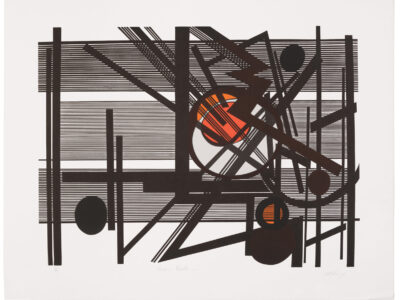
Class of ’86 | Tracking down missing Oscars may not be everyone’s idea of a party. But while curating a Noël Coward exhibition, Brad Rosenstein C’86 had a ball grilling the denizens of Old Hollywood for tips that might lead to one of the Academy Awards for Cavalcade, the 1933 movie based on Coward’s play.
“I’d run into all these family dynamics,” laughs Rosenstein. “We’d have a lovely little chat about the exhibit before I’d spring the question: ‘Do you have the Oscar statuette?’ Then dead silence, followed by, ‘Well, there was a second wife …’ and then the stories would really start to spill out. We thought we should start our own reality show called Oscar Cops.
“Of course, after weeks of tracking it down, it turned out to be in the Academy vault all along,” he adds. “But it was worth it—there’s a glow, a patina to the real objects, and visitors can sense it.”
Such attention to detail has made Rosenstein not only an emerging authority on Coward—the late British playwright, composer, director, and performer known for such plays as Private Lives and Blithe Spirit—but also a natural curator, an unexpected second act to a career begun as a playwright and theater director. This spring marks Rosenstein’s third and most expansive incarnation of Star Quality: The World of Noël Coward, an exhibition that runs from March 12 to August 18 at the New York Public Library for the Performing Arts at Lincoln Center, and which represents the centerpiece of New York’s city-wide Noël Coward Festival 2012.
“There’s been more Coward activity in the last three years than at any time since his death nearly 40 years ago,” says Rosenstein, referring to a worldwide resurgence of productions, including major revivals of Coward plays in New York and London. “He clearly still speaks to people, especially younger people who grew up on Adam Sandler and fart jokes. He offers a rich alternative to that. In Coward’s world, everyone dresses fabulously, and speaks beautifully, and is hilariously funny. They do it all with wit, style, and romanticism. It’s touched a nerve and is filling a need.”
While searching for artifacts with his “amazing collaborators” at the Noël Coward Foundation, Rosenstein’s most delightful discovery was Geoff Johnson C’52, a fellow Penn grad and sole surviving member of Coward’s inner circle. Johnson, who worked for Coward and ran a highly successful Broadway casting company before becoming a Coward Foundation trustee, imbued the exhibit with behind-the-scenes tales of hobnobbing with stars like Greta Garbo and Elizabeth Taylor.
For Rosenstein, Johnson was a treasure trove of stories and artifacts.
“I still have several oil and casein landscape paintings that Noël did,” says Johnson. “Brad was so enthusiastic—he’d ask me about specific things, or where he could go to find things out. As a curator, I think he’s phenomenal. His knowledge is incredible about the theater. I was in London with him at a storage unit filled with all this material from Noël Coward’s past. He was like a kid in a toy store. I thought we were in FAO Schwarz—he was going crazy. He really cared about what he saw and knew the history.”
Rosenstein honed his love of theater at Penn, where he performed in student productions and studied playwriting with Romulus Linney (the father of actress Laura Linney). After graduating, he co-founded Philadelphia’s InterAct Theatre Company with Seth Rozin C’86 [“Alumni Profiles,” Jan|Feb 2004], Erica L. Schwartz C’89, and David Goldstein C’85. Although most of the dozen or so plays he wrote were mounted in Philly, New York, and even Berlin, “I always felt like I had to reinvent the wheel each time,” he says. Frustrated by the economics and politics of trying to gain a foothold in New York, he moved to San Francisco in 1994 to be part of its thriving theater scene, only to watch the funding for new plays evaporate that same year. He boosted his income as an arts journalist and critic, produced several pieces for radio, and wrote a play, The Vermeer Room, that won the National Play Award in 2000. It seemed poised to be his ticket.
“That play did everything right,” he says. “It won a major national award, was written up in The New York Times, got me a New York agent. We killed ourselves for two solid years trying to get a production launched. Audiences would go crazy at readings, but no one would do it. It was never produced anywhere. That was a turning point in reassessing my career.”
He was also starting a family, necessitating a steady paycheck.
“I was looking for something more reliable than playwriting, but still in the field,” he says. “Out of the blue, the Museum of Performance & Design [MPD] in San Francisco hired me as its education and program director. Tacked onto that was overseeing exhibitions, which became for me the most compelling aspect of the job. I saw that the exhibitions could drive everything we did.”
For the next 10 years, Rosenstein served as curator of exhibitions and programs at the MPD, where he supervised more than 60 exhibitions and personally curated some of the most popular, including Hirschfeld: A Centennial Celebration; Madame Butterfly: From Puccini to Miss Saigon; and More Life! Angels in America at Twenty.
Rosenstein’s journey with Noël Coward began in 2008, when a colleague who had curated an earlier incarnation of the exhibition in London contacted him about presenting the show in San Francisco. Rosenstein greatly expanded the exhibition to encompass the full range of Coward’s personal and professional life. The result was a smash hit with all ages, including wildly enthusiastic visitors in their 20s and 30s.
Realizing that he was on to something, he remounted the show in 2010 at the Academy of Motion Picture Arts and Sciences in LA, and expanded it to include Coward’s film contributions. By the time budget cuts forced his departure from MPD last June, Lincoln Center had called.
“I never would have thought of curating as a career, but it’s so similar to putting on a show in a theater,” says Rosenstein. “You’re trying to tell a story in real time and space, and give people an actual experience rather than simply talking about something. Even my journalism background plays into the research, accessing and interviewing people, and setting the historical record straight. I may not be writing plays, but I’m still telling stories. And invariably, the real story turns out to be much more interesting than the legend.”
—Susan Karlin C’85




